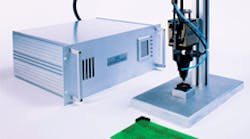Authored by: Chris Korson Edited by Jessica Shaprio Keypoints: Resources: "Picking plastics to laser weld," Machine Design, Sept. 18, 2003 |
Manufacturers of electronic components with printed-circuit boards (PCBs) have a new method for mounting PCBs to their respective thermoplastic housings or substrates: laser staking.
The technology uses the same principles as laser plastic welding. A material transparent to the laser beam is joined to a material which absorbs the laser energy. The absorbed energy is transmitted as heat through the absorbing material and melts both the absorber and the transparent layer through conduction. The technique is sometimes referred to as laser through-transmission welding (LTTW).
LTTW induces little mechanical stress on parts, produces a small heat-affected zone compared to melt-based joining, creates a joint which is air and watertight, and is highly reproducible. Process engineers use it to reliably create tight seals in multipiece housings which may contain sensitive electronics such as sensors and lighting assemblies.
Laser staking makes smaller bonds than laser plastic welding but uses the same underlying principle. Fingers, or stakes, in the injection-molded PCB housing align with holes in the PCB to stand above the surface. The joining partner, a rivet head made from a laser-transparent material, is placed in contact and under pressure at the end of the stake.
A single-emitter laser diode emits a 980-nm wavelength beam, the same type used for LTTW. The laser usually uses 20 to 50 W; the most common power level is 30 W. The rivet head transmits the process laser’s radiation. The stake and housing usually contain an additive like carbon black that let them absorb the laser energy.
The absorbed laser energy heats the finger. Heat migrates from there into the rivet head by thermal conduction until both the rivet and finger have melted. The pressure applied to the rivet pushes the rivet head into contact with the PCB, locking the PCB to the housing. The entire process takes a fraction of a second.
This method replaces processes commonly used in mass production to join PCBs to their housings. But screwing, gluing, mechanical or ultrasonic riveting, and heat staking each has drawbacks.
Screws and rivets require extra prejoining operations to tap, drill, or mold the fastener hole. And it takes careful control of these operations to ensure fasteners fit securely and surrounding electronics aren’t damaged. In addition, screws can work themselves loose in high-vibration environments if not properly secured.
Joining a PCB to its housing with adhesive may require surface preparation with abrasives, plasma treatment, or harsh chemicals. Operators must apply these carefully or mask off sensitive areas to avoid damage.
Heat staking applies elevated temperatures directly to injection-molded housings. The temperatures involved can be enough to create a heat-affected zone in the surrounding housing and PCB material, and heat application can be harder to monitor than laser energy.
The laser-staking tool is about the same size as an industrial pneumatic screwdriver. The module and process controller, including all components, fit inside a 19-in. housing joined to the processing module by supply lines.
An external interface lets engineers and operators remotely access all input and output signals, including setting and adjusting parameters and monitoring the process. The interface also makes the device a good candidate for use in a fully automated laser-staking cell in which a control system monitors crucial parameters and regulates joining in real time.
Another benefit of laser staking is that engineers can track production more effectively than can be done with ultrasonic riveting or heat staking. The system can read out and store the results of each laser-staking operation, letting managers see trends and statistics.
In addition to fastening PCBs in place, laser staking also works in any application where automated machines rivet a substrate to a housing. Magnets and other metallic components, nonmetallics, ceramics, thermoplastics, and other materials can all be laser staked to a housing by this method.
Almost all thermoplastics that can be laser welded can also be used in laser staking, including polyamides (nylons), polypropylenes, polybutylene terephthalates, polyoxymethylenes (acetals), polycarbonates, and polyethylenes. The rivet and the housing are generally the same base resin or part of the same resin family.
